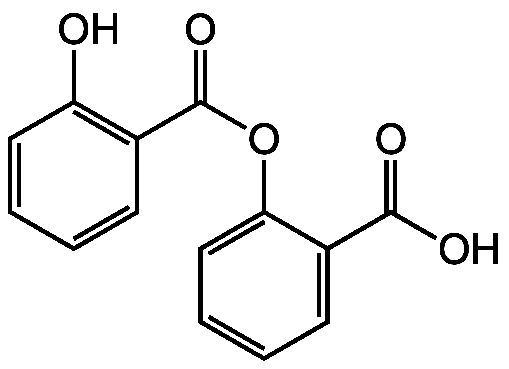
Chemical Structure
Salsalate
AG-CR1-3574
CAS Number552-94-3
Product group Chemicals
Estimated Purity>98%
Molecular Weight258.2
Overview
- SupplierAdipoGen Life Sciences
- Product NameSalsalate
- Delivery Days Customer10
- CAS Number552-94-3
- CertificationResearch Use Only
- Estimated Purity>98%
- Hazard InformationWarning
- Molecular FormulaC14H10O5
- Molecular Weight258.2
- Scientific DescriptionChemical. CAS: 552-94-3. Formula: C14H10O5. MW: 258.2. Nonacetylated salicylate. Non-steroidal anti-inflammatory drug (NSAID). Reduces pain and inflammation caused by conditions such as rheumatoid arthritis, osteoarthritis and related rheumatic conditions. Prostaglandin synthesis inhibitor in vivo. Inactivates cyclooxygenase-1 (COX-1) and -2 (COX-2). IKKbeta/NF-kappaB inhibitor (at significantly higher concentrations than required for COX inhibition). Used to target inflammation in the treatment of insulin resistance, type 2 diabetes, or rheumatic pain. It reduces blood glucose concentrations in patients with type 2 diabetes, as well as in insulin-resistant patients without diabetes. Reduces blood glucose, triglyceride, free fatty acid and C-reactive protein concentrations, improves glucose utilization and increases circulating insulin and adiponectin concentrations in obese adults at risk for the development of type 2 diabetes as well as for patients with type 2 diabetes. Dimeric prodrug comprising two esterified salicylate moieties. It is advantageous over sodium salicylate because it is insoluble at the acid pH of the stomach and passes suspended but undissolved into the small intestine, sparing the gastric mucosa direct contact. - Nonacetylated salicylate. Non-steroidal anti-inflammatory drug (NSAID). Reduces pain and inflammation caused by conditions such as rheumatoid arthritis, osteoarthritis and related rheumatic conditions. Prostaglandin synthesis inhibitor in vivo. Inactivates cyclooxygenase-1 (COX-1) and -2 (COX-2). IKKbeta/NF-kappaB inhibitor (at significantly higher concentrations than required for COX inhibition). Used to target inflammation in the treatment of insulin resistance, type 2 diabetes, or rheumatic pain. It reduces blood glucose concentrations in patients with type 2 diabetes, as well as in insulin-resistant patients without diabetes. Reduces blood glucose, triglyceride, free fatty acid and C-reactive protein concentrations, improves glucose utilization and increases circulating insulin and adiponectin concentrations in obese adults at risk for the development of type 2 diabetes as well as for patients with type 2 diabetes. Dimeric prodrug comprising two esterified salicylate moieties. It is advantageous over sodium salicylate because it is insoluble at the acid pH of the stomach and passes suspended but undissolved into the small intestine, sparing the gastric mucosa direct contact.
- SMILESOC(=O)C1=CC=CC=C1OC(=O)C1=C(O)C=CC=C1
- Storage Instruction-20°C,2°C to 8°C
- UN NumberUN 3077
- UNSPSC12352200

![Salsalate [552-94-3]](https://www.targetmol.com/group3/M00/34/6E/CgoaEWardAuEF7mqAAAAADSjJCE451.png)
